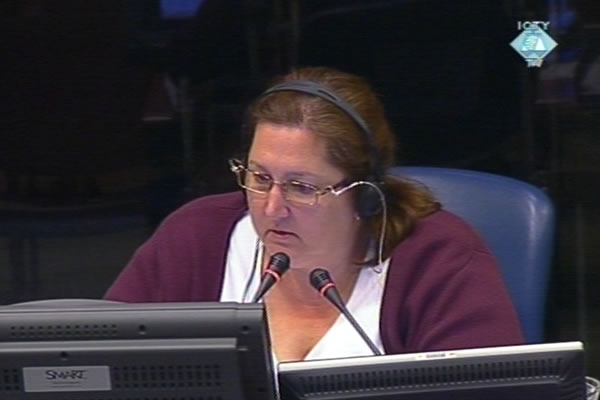Home
CRISIS STAFFS RELOCATED PEOPLE AS PART OF POLICY
In her evidence at the trial of Radovan Karadzic, prosecution expert Dorothea Hanson says that crisis staffs implemented the policy of relocation of non-Serbs. Karadzic is charged with genocide and other crimes in BH
 Dorothea Hanson, witness at the Radovan Karadzic trial
Dorothea Hanson, witness at the Radovan Karadzic trial At the trial of Radovan Karadzic for genocide and other crimes in Bosnia and Herzegovina, the prosecution examined its expert witness Dorothea Hanson. Hanson drafted a report on the operation of crisis staffs in Bosnia and Herzegovina from 1992 to 1995.
As Hanson says, crisis staffs were established in line with the instruction issued by the SDS Executive Board on 19 December 1991. The instruction is known as Variant A and B. The establishment of crisis staffs, or ‘shadow governments’, as the witness called them, was planned in the first phase of the implementation of Variant A. According to Variant A, power was to be seized in the municipalities with Serb majority. The second stage in the implementation of Variant A was the takeover of police stations and the establishment of municipal authorities.
According to the evidence of the president of the Crisis Staff in the Novo Sarajevo municipality Radomir Neskovic, Karadzic personally distributed copies of the instruction at the expanded SDS leadership meeting in the Holiday Inn hotel in Sarajevo, in late December 1991. Copies of the instruction were found in a number of municipalities throughout BH: in Sarajevo, Gorazde, Livno, Trnovo...
In her report, Hansen says that the municipal leaders consulted the party leadership about how to implement the instruction. At a meeting held in February 1992, Karadzic demanded that the municipal leaders expedite the implementation of Variant A in order to gain effective power over ‘every millimeter of our land’.
On 4 April 1992, Karadzic issued a declaration activating all the crisis staffs; the purpose was to fully sidetrack the ‘rump BH Presidency’, Hansen said. In late April 1992, the government issued the instructions for the operation of the crisis staffs, regulating their structure, jurisdiction and activities. According to the instructions, the representatives of all the armed forces in the municipalities became members of a crisis staff. Civilian prisoners and prisoners of war were under the jurisdiction of crisis staffs. The prosecution corroborated this claim with the example of Prijedor, where the police set up the infamous prison camp Omarska based on a decision issued by the local crisis staff.
The crisis staffs implemented the policy of relocation of non-Serbs. First, they forced the people to sign a document ceding the ownership of their property to the municipality, the witness explained. The crisis staffs then provided transportation. Alternatively, they required the non-Serbs to pay for their own transportation, and restricted the amount of money the non-Serbs could take with them.
Karadzic began his cross-examination by claiming that the prosecution expert’s report was full of examples ‘representative of the culpability of the Serb side’ while ‘exculpatory examples’ were left out. Hansen dismissed the accusation. As she said, if she had found among the thousands of documents she had reviewed any information indicating there was a pattern of behavior which favored Karadzic’s case, she would have put it in her report.
The trial of Radovan Karadzic continues on Tuesday, 14 June 2011.
Linked Reports
- Case : Karadzic
- 2011-06-08 KARADZIC’S VERSION OF HISTORY AND REALITY
- 2011-06-07 WITNESS: BATKO WAS ‘AN ARMED MONSTER’
- 2011-06-06 WITNESS: KARADZIC ‘EXPECTED OBEDIENCE’
- 2011-06-15 KARADZIC: EVERYTHING WAS IN LINE WITH THE LAW
- 2011-06-17 DENYING THE ‘POLICY OF RESETTLEMENT’ OF MUSLIMS AND CROATS
- 2011-06-20 DID COMMUNICATIONS IN REPUBLIKA SRPSKA FUNCTION?
